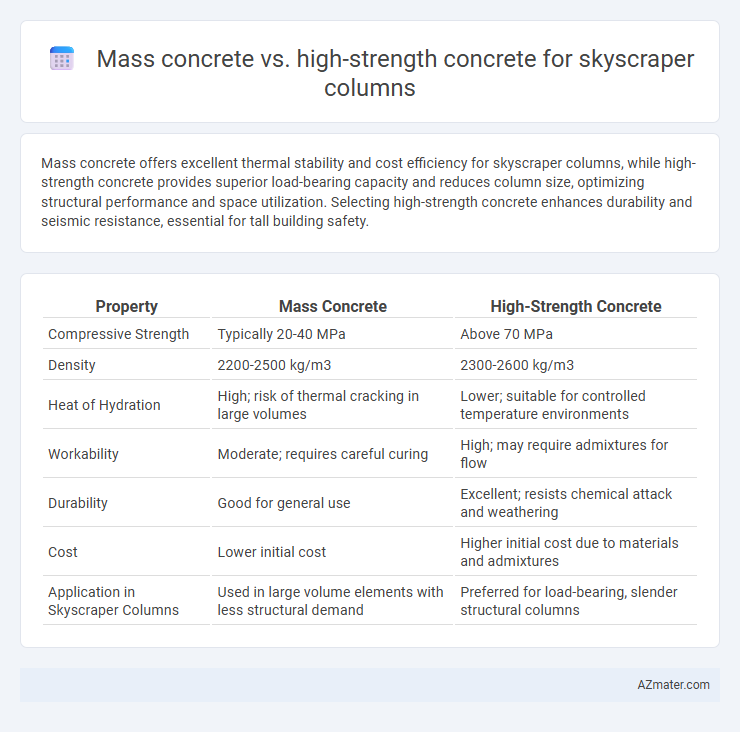Mass concrete offers excellent thermal stability and cost efficiency for skyscraper columns, while high-strength concrete provides superior load-bearing capacity and reduces column size, optimizing structural performance and space utilization. Selecting high-strength concrete enhances durability and seismic resistance, essential for tall building safety.
Table of Comparison
| Property | Mass Concrete | High-Strength Concrete |
|---|---|---|
| Compressive Strength | Typically 20-40 MPa | Above 70 MPa |
| Density | 2200-2500 kg/m3 | 2300-2600 kg/m3 |
| Heat of Hydration | High; risk of thermal cracking in large volumes | Lower; suitable for controlled temperature environments |
| Workability | Moderate; requires careful curing | High; may require admixtures for flow |
| Durability | Good for general use | Excellent; resists chemical attack and weathering |
| Cost | Lower initial cost | Higher initial cost due to materials and admixtures |
| Application in Skyscraper Columns | Used in large volume elements with less structural demand | Preferred for load-bearing, slender structural columns |
Introduction to Mass Concrete and High-Strength Concrete
Mass concrete is characterized by its large volume and low heat of hydration, commonly used in foundations and large structural elements to minimize thermal cracking, whereas high-strength concrete features compressive strengths exceeding 40 MPa, ideal for slender skyscraper columns requiring enhanced load-carrying capacity. High-strength concrete utilizes optimized mix designs with supplementary cementitious materials such as silica fume and fly ash to improve durability and mechanical properties, while mass concrete relies on controlling temperature gradients and moisture to maintain structural integrity. The selection between mass concrete and high-strength concrete in skyscraper columns depends on structural demands, load-bearing requirements, and thermal management considerations.
Key Properties of Mass Concrete in Structural Applications
Mass concrete for skyscraper columns exhibits high thermal capacity and low permeability, crucial for controlling temperature gradients and minimizing thermal cracking during hydration. Its substantial volume and slower strength gain enhance durability and stability under sustained loads in large structural elements. The dense composition and low heat of hydration reduce shrinkage and improve long-term performance compared to high-strength concrete, which prioritizes compressive strength but may be more prone to brittleness and thermal stresses.
Unique Features of High-Strength Concrete for Skyscrapers
High-strength concrete for skyscraper columns offers exceptional compressive strength exceeding 6000 psi, enabling slimmer column profiles that maximize usable floor space. Its low permeability and enhanced durability provide superior resistance to environmental stressors and reduce long-term maintenance costs. Advanced mix designs incorporating supplementary cementitious materials improve workability and reduce heat of hydration, minimizing thermal cracking in tall structures.
Comparative Strength Benefits for Skyscraper Columns
High-strength concrete offers significantly higher compressive strength than mass concrete, allowing for slimmer, lighter skyscraper columns that optimize structural efficiency and maximize usable floor space. Mass concrete provides excellent thermal stability and durability, essential for large column sections in skyscrapers, but its lower strength requires bulkier dimensions. The enhanced load-bearing capacity of high-strength concrete supports greater vertical loads and seismic forces, making it the preferred choice for optimizing skyscraper column performance.
Thermal Management: Mass vs High-Strength Concrete
Mass concrete in skyscraper columns offers superior thermal inertia, effectively moderating temperature fluctuations and reducing thermal cracking risks during hydration. High-strength concrete, while possessing higher compressive strength, generates more heat of hydration, increasing thermal gradients and potential for microcracking without adequate cooling measures. Proper thermal management strategies are critical for high-strength concrete to ensure durability and structural integrity in tall building columns.
Workability and Placement: Practical Considerations
Mass concrete for skyscraper columns offers superior thermal stability and easier placement due to its lower cement content and higher slump retention, making it suitable for thick sections where heat dissipation is crucial. High-strength concrete, with its lower water-cement ratio and increased rigidity, presents workability challenges requiring advanced admixtures and careful vibration to ensure proper consolidation and avoid honeycombing. Practical placement considerations favor mass concrete in large volume pours to reduce cracking risk, while high-strength concrete demands specialized handling techniques to maintain workability without compromising structural integrity.
Durability and Longevity in High-Rise Structures
Mass concrete in skyscraper columns offers robust durability through its inherent low permeability and resistance to thermal cracking, vital for high-rise structures subject to large load demands and environmental stress. High-strength concrete enhances longevity by providing superior compressive strength and improved resistance to chemical attack, which is critical in urban environments with aggressive pollutants. Optimizing the balance between mass concrete's thermal stability and high-strength concrete's mechanical properties ensures enhanced durability and lifespan of skyscraper columns in demanding high-rise construction.
Cost Analysis: Material and Construction Efficiency
Mass concrete for skyscraper columns offers lower initial material costs due to the use of coarse aggregates and less cement, while high-strength concrete entails higher expenses with specialized admixtures and cementitious materials. Construction efficiency with mass concrete benefits from simplified mix design and easier placement, but high-strength concrete enables thinner columns, reducing overall material quantity and foundation loads, potentially lowering long-term project costs. A detailed cost analysis must balance immediate material savings against structural performance and lifecycle benefits to optimize economic and construction efficiency in skyscraper projects.
Sustainability and Environmental Impact
Mass concrete for skyscraper columns offers superior thermal mass, reducing energy consumption for temperature regulation while relying on locally sourced materials with lower embodied carbon. High-strength concrete features reduced material volume and enhanced load-bearing capacity, minimizing the carbon footprint associated with formwork and transportation but often incorporates higher cement content, which increases CO2 emissions. Sustainable design balances using mass concrete's energy efficiency benefits against the environmental costs of high-strength mixes, aiming to optimize material selection for reduced lifecycle carbon impact.
Conclusion: Optimal Concrete Choice for Skyscraper Columns
High-strength concrete offers superior compressive strength and durability, making it the optimal choice for skyscraper columns where space efficiency and load-bearing capacity are critical. Mass concrete, while effective for large volume pours, generally lacks the strength-to-weight ratio required for slender, high-rise structural elements. Therefore, selecting high-strength concrete ensures enhanced structural performance, reduced column dimensions, and improved seismic resistance in skyscraper designs.

Infographic: Mass concrete vs High-strength concrete for Skyscraper column
 azmater.com
azmater.com